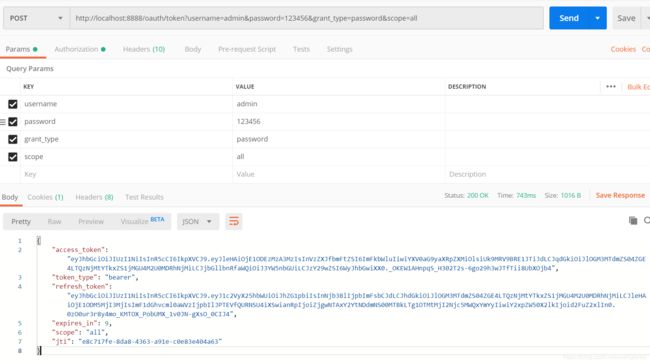SpringCloud oauth整合JWT(一) -- 思路介绍与认证服务器实现
注意:这里只是讲解oauth与jwt整合,不过多的介绍单个技术
1.oauth 2.0
OAuth2.0是OAuth协议的延续版本,但不向前兼容OAuth 1.0(即完全废止了OAuth1.0)。 OAuth 2.0关注客户端开发者的简易性。要么通过组织在资源拥有者和HTTP服务商之间的被批准的交互动作代表用户,要么允许第三方应用代表用户获得访问的权限。同时为Web应用,桌面应用和手机,和起居室设备提供专门的认证流程。
2.JWT
JSON Web Token(JWT)是一个非常轻巧的规范,这个规范允许我们使用JWT在用户与服务器传递安全可靠的信息。
3.为什么需要两者结合
首先,这些的前提都是在分布式服务的前提下,如果你的服务或者是应用不考虑分布式,甚至是不考虑用户的使用感受,那么你可以有无数种实现权限控制的方式,但如果如博主所说需要oauth与jwt,那么就说明你的服务是复杂的,是需要更加严谨的权限控制,那么请读者仔细的阅读博文的以下内容。
- 单独使用jwt:进行加密后会生成一串字符串,可以用加密的秘钥进行解密,可以将用户信息进行加密当做token进行登录的验证(只能存储非隐私的信息),但是无法完成对某个特定权限的控制和对某些接口的权限限制,短板较多且不够灵活。
- 单独使用oauth:在单个项目组成的项目中,oauth可以完成认证与授权,但在多服务的情况下,做单点登录的时候需要不停的访问认证服务器,这时候或造成认证服务器的高压,且会影响接口的响应效率。
- 两者结合:jwt将用户的信息加密后生成有意义的token,而不是oauth那样生成的没有任何意义的UUID,然后oauth又有很优秀的权限控制体系,直接用jwt的token就可以下多个服务间进行使用,结合jwt的token****于oauth的权限控制,可以加强服务安全体系的完善。
3.认证服务器
1.pom依赖
<dependencies>
<dependency>
<groupId>org.springframework.cloudgroupId>
<artifactId>spring-cloud-starter-oauth2artifactId>
dependency>
<dependency>
<groupId>io.jsonwebtokengroupId>
<artifactId>jjwtartifactId>
<version>0.9.0version>
dependency>
<dependency>
<groupId>org.springframework.securitygroupId>
<artifactId>spring-security-jwtartifactId>
<version>1.0.9.RELEASEversion>
dependency>
<dependency>
<groupId>org.projectlombokgroupId>
<artifactId>lombokartifactId>
<version>1.16.20version>
dependency>
<dependency>
<groupId>com.alibabagroupId>
<artifactId>fastjsonartifactId>
<version>1.2.47version>
dependency>
<dependency>
<groupId>org.springframework.bootgroupId>
<artifactId>spring-boot-starter-data-redis-reactiveartifactId>
dependency>
dependencies>
2.security配置
package com.wangle.server.config;
import org.springframework.beans.factory.annotation.Autowired;
import org.springframework.context.annotation.Bean;
import org.springframework.context.annotation.Configuration;
import org.springframework.security.authentication.AuthenticationManager;
import org.springframework.security.config.annotation.authentication.builders.AuthenticationManagerBuilder;
import org.springframework.security.config.annotation.web.builders.HttpSecurity;
import org.springframework.security.config.annotation.web.configuration.EnableWebSecurity;
import org.springframework.security.config.annotation.web.configuration.WebSecurityConfigurerAdapter;
import org.springframework.security.crypto.bcrypt.BCryptPasswordEncoder;
import org.springframework.security.crypto.password.PasswordEncoder;
@Configuration
@EnableWebSecurity
public class SecurityConfig extends WebSecurityConfigurerAdapter {
// 注入用户自定义认证逻辑
@Autowired
private MyUserDetailService userDetailService;
@Autowired
private PasswordEncoder passwordEncoder;
@Override
@Bean
public AuthenticationManager authenticationManagerBean() throws Exception {
return super.authenticationManagerBean();
}
@Override
protected void configure(HttpSecurity http) throws Exception {
http.requestMatchers()
.antMatchers("/**")
.and()
.authorizeRequests()
.anyRequest().authenticated()
.and()
.formLogin().permitAll();
}
@Override
protected void configure(AuthenticationManagerBuilder auth) throws Exception {
auth.userDetailsService(userDetailService)
.passwordEncoder(passwordEncoder); //密码加密
}
}
2.tokenStore配置
package com.wangle.server.config;
import org.springframework.beans.factory.annotation.Autowired;
import org.springframework.context.annotation.Bean;
import org.springframework.context.annotation.Configuration;
import org.springframework.data.redis.connection.RedisConnectionFactory;
import org.springframework.security.oauth2.provider.token.TokenStore;
import org.springframework.security.oauth2.provider.token.store.JwtAccessTokenConverter;
import org.springframework.security.oauth2.provider.token.store.JwtTokenStore;
import org.springframework.security.oauth2.provider.token.store.redis.RedisTokenStore;
@Configuration
public class TokenStoreConfig {
// 注入redis连接工厂
@Autowired
private RedisConnectionFactory redisConnectionFactory;
@Bean
public TokenStore jwtTokenStore() {
return new JwtTokenStore(jwtAccessTokenConverter());
}
@Bean
public TokenStore redisTokenStore() {
return new RedisTokenStore(redisConnectionFactory);
}
@Bean
public JwtAccessTokenConverter jwtAccessTokenConverter() {
JwtAccessTokenConverter accessTokenConverter = new JwtAccessTokenConverter();
accessTokenConverter.setSigningKey("test_key");//配置JWT使用的秘钥
return accessTokenConverter;
}
@Bean
public JwtTokenEnhancer jwtTokenEnhancer() {
return new JwtTokenEnhancer();
}
}
3.认证配置
package com.wangle.server.config;
import com.alibaba.fastjson.JSON;
import io.jsonwebtoken.Jwts;
import org.springframework.beans.factory.annotation.Autowired;
import org.springframework.context.annotation.Bean;
import org.springframework.context.annotation.Configuration;
import org.springframework.context.annotation.Primary;
import org.springframework.data.redis.connection.RedisConnectionFactory;
import org.springframework.security.authentication.AuthenticationManager;
import org.springframework.security.crypto.password.PasswordEncoder;
import org.springframework.security.oauth2.common.DefaultOAuth2AccessToken;
import org.springframework.security.oauth2.common.OAuth2AccessToken;
import org.springframework.security.oauth2.config.annotation.configurers.ClientDetailsServiceConfigurer;
import org.springframework.security.oauth2.config.annotation.web.configuration.AuthorizationServerConfigurerAdapter;
import org.springframework.security.oauth2.config.annotation.web.configuration.EnableAuthorizationServer;
import org.springframework.security.oauth2.config.annotation.web.configurers.AuthorizationServerEndpointsConfigurer;
import org.springframework.security.oauth2.config.annotation.web.configurers.AuthorizationServerSecurityConfigurer;
import org.springframework.security.oauth2.provider.OAuth2Authentication;
import org.springframework.security.oauth2.provider.token.DefaultTokenServices;
import org.springframework.security.oauth2.provider.token.TokenEnhancer;
import org.springframework.security.oauth2.provider.token.TokenEnhancerChain;
import org.springframework.security.oauth2.provider.token.TokenStore;
import org.springframework.security.oauth2.provider.token.store.JwtAccessTokenConverter;
import org.springframework.security.oauth2.provider.token.store.JwtTokenStore;
import org.springframework.security.oauth2.provider.token.store.redis.RedisTokenStore;
import java.nio.charset.StandardCharsets;
import java.util.*;
@Configuration
@EnableAuthorizationServer
public class ServerConfig extends AuthorizationServerConfigurerAdapter {
// 注入认证管理器
@Autowired
private AuthenticationManager authenticationManager;
@Autowired
private PasswordEncoder passwordEncoder;
@Autowired
private TokenStore redisTokenStore;
// 注入用户自定义认证逻辑
@Autowired
private MyUserDetailService userDetailService;
@Autowired
private JwtAccessTokenConverter jwtAccessTokenConverter;
@Autowired
private TokenStore jwtTokenStore;
@Autowired
private JwtTokenEnhancer jwtTokenEnhancer;
@Override
public void configure(AuthorizationServerSecurityConfigurer security) throws Exception {
security
.allowFormAuthenticationForClients()
.tokenKeyAccess("permitAll()")
.checkTokenAccess("isAuthenticated()");
}
//定义客户端的信息
@Override
public void configure(ClientDetailsServiceConfigurer clients) throws Exception {
clients.inMemory().withClient("wangle")
.secret(passwordEncoder.encode("wangle"))
// .resourceIds("admin","auth")
//设置token的有效期,不设置默认12小时
//.accessTokenValiditySeconds(client.getAccessTokenValidatySeconds())
//设置刷新token的有效期,不设置默认30天
//.refreshTokenValiditySeconds(client.getRefreshTokenValiditySeconds())
.redirectUris("http://www.baidu.com")
.authorizedGrantTypes("authorization_code","client_credentials", "refresh_token", "password")
.scopes("all", "read", "write")
.accessTokenValiditySeconds(10)
.autoApprove(true);
}
//自定义web响应错误翻译器
/*
* @Bean public WebResponseExceptionTranslator webResponseExceptionTranslator(){
* return new MssWebResponseExceptionTranslator(); }
*/
/**
*
* 注意,自定义TokenServices的时候,需要设置@Primary,否则报错,
*
*
* @return
*/
@Primary
@Bean
public DefaultTokenServices myTokenServices() {
DefaultTokenServices tokenServices = new DefaultTokenServices();
tokenServices.setTokenStore(jwtTokenStore);
tokenServices.setSupportRefreshToken(true);
// tokenServices.setClientDetailsService(clientDetails());
// token有效期自定义设置,默认12小时
tokenServices.setAccessTokenValiditySeconds(60 * 60 * 12);
// refresh_token默认30天
tokenServices.setRefreshTokenValiditySeconds(60 * 60 * 24 * 7);
return tokenServices;
}
@Override
public void configure(AuthorizationServerEndpointsConfigurer endpoints) throws Exception {
TokenEnhancerChain enhancerChain = new TokenEnhancerChain();
List<TokenEnhancer> delegates = new ArrayList<>();
delegates.add(jwtTokenEnhancer); //配置JWT的内容增强器
delegates.add(jwtAccessTokenConverter);
enhancerChain.setTokenEnhancers(delegates);
endpoints
.userDetailsService(userDetailService)
//定义权限终点的token存储方式
.tokenStore(redisTokenStore)
//定义权限终点的user认证逻辑
.accessTokenConverter(jwtAccessTokenConverter)
//定义权限终点的认证管理器
.authenticationManager(authenticationManager)
//jwt增强
//.tokenEnhancer(enhancerChain)
//认证异常翻译
//endpoints.exceptionTranslator(webResponseExceptionTranslator());
;
}
}
ClientDetailsServiceConfigurer可以使用以上的,也可以配置成从数据库获取,具体的实现方式这里不做介绍。
3.自定义用户验证实现
package com.wangle.server.config;
import io.jsonwebtoken.Jwts;
import org.springframework.beans.factory.annotation.Autowired;
import org.springframework.security.core.GrantedAuthority;
import org.springframework.security.core.authority.SimpleGrantedAuthority;
import org.springframework.security.core.userdetails.User;
import org.springframework.security.core.userdetails.UserDetails;
import org.springframework.security.core.userdetails.UserDetailsService;
import org.springframework.security.core.userdetails.UsernameNotFoundException;
import org.springframework.security.crypto.bcrypt.BCryptPasswordEncoder;
import org.springframework.security.crypto.password.PasswordEncoder;
import org.springframework.stereotype.Service;
import java.nio.charset.StandardCharsets;
import java.util.HashSet;
@Service("userDetailService")
public class MyUserDetailService implements UserDetailsService {
@Autowired
private PasswordEncoder passwordEncoder;
// 重写loadUserByUsername(实现用户认证逻辑)
@Override
public UserDetails loadUserByUsername(String mobile) throws UsernameNotFoundException {
// 初始化权限集合
HashSet<GrantedAuthority> authorities = new HashSet<>();
// 可用性 :true:可用 false:不可用
boolean enabled = true;
// 过期性 :true:没过期 false:过期
boolean accountNonExpired = true;
// 有效性 :true:凭证有效 false:凭证无效
boolean credentialsNonExpired = true;
// 锁定性 :true:未锁定 false:已锁定
boolean accountNonLocked = true;
// 角色名必须是以ROLE_开头,不然权限注解无法识别此角色
SimpleGrantedAuthority grantedAuthority = new SimpleGrantedAuthority("ROLE_ADMIN");
authorities.add(grantedAuthority);
User principle = new User(mobile,passwordEncoder.encode("123456"), enabled, accountNonExpired,
credentialsNonExpired, accountNonLocked, authorities);
return principle;
}
}
